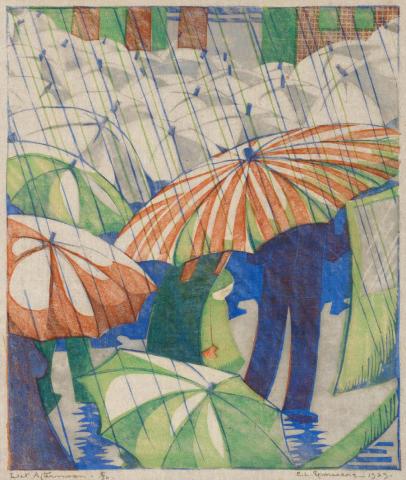WET AFTERNOON, 1929
ETHEL SPOWERS
colour linocut on buff oriental laid tissue
24.0 x 20.0 cm
edition: 8/50
signed, dated, titled and numbered below image
Estate of Oswald Syme, Melbourne
Thence by descent
Private collection, Victoria
British Linocuts, The Redfern Gallery, London, 23 July – 23 August 1930, cat. 5 (another example)
Exhibition of Linocuts, Everyman's Lending Library, Melbourne, 9 – 24 December 1930, cat. 24 (another example) Society of Artists Annual Exhibition, Education Department's Gallery, Sydney, 2 – 30 September 1932, cat. 53 (another example)
Coppel, S., Linocuts of the Machine Age: Claude Flight and the Grosvenor School, Scolar Press, Aldershot, England, in assoc. National Gallery ofAustralia, 1995, pl. 37, p. [44] and pp. 170–171, cat. ES14 (illus., another example)
Other examples of this print are held in the collections of the National Gallery of Australia, Canberra, the National Gallery of Victoria, Melbourne, and the Art Gallery of New South Wales, Sydney
Ethel Spowers returned to London late 1928 after first exhibiting there in 1921. Together with her close Melbourne friend Eveline Syme she studied for some months at the Grosvenor School of Modern Art under Iain Macnab and Claude Flight. Particularly under Flight's linocut teaching, Spowers' art underwent a rapid transformation from illustrative Japanese-inspired woodcuts and linocuts of the mid-1920s to rhythmic modern designs representative of the spirit of their era.
At the Grosvenor School, Claude Flight was a dynamic and inspired teacher who had himself experienced an enormous stylistic transformation towards'a new art of the modern machine age, expressive of speed, dynamism and energy'.1 During the 1920s Flight was an active member of the Seven and Five Society, whose members included Ben Nicholson, Barbara Hepworth and Henry Moore. His work was widely reproduced in leading art magazines such as The Studio and Colour. The more avant-garde Ray magazine illustrated Flight's work alongside that of Nicholson, Kurt Schwitters, Andre Mason and Moholy-Nagy.
The possibilities of a new era of British modern art had been announced by Filippo Marinetti, founder of the Italian Futurists, when Works by the Italian Futurists were exhibited in London in March 1912. 'Why, London itself is a Futurist City! Look at those brilliant hued motor-buses, those enormous, glaring posters...'2 Flight was obviously influenced by Marinetti's ideas on dynamism of the modern machine age.
Like the Futurists, Flight proclaimed an art in keeping with modern life, a dynamic and expressive vision.'The subjects which I have taken are such things as buses coming down a street, waves breaking on the shore or carrying a ship on sea, dancing, or the movement in a crowd, swings or the eddies of the wind and rain: all these have their particular significant rhythm which I have been trying to grasp and place in my colour prints...'3
The Australians, Ethel Spowers, Eveline Syme and Dorrit Black all arrived at the Grosvenor School at the height of its influence. Together with other British and overseas artists such as Cyril Power, Sybil Andrews and Lill Tschudi, these artists produced some of the most significant prints of British and Australian modernism. Spowers' Wet Afternoon 1929 comes from a short two year period of remarkable Grosvenor School images: Claude Flight'sBrooklands 1929, Cyril Power's The Tube Staircase 1929 and The Giant Racer c.1930, Sybil Andrews Concert Hall 1929, Lill Tschudi's Jazz Band 1930, Dorrit Black's Argentina c.1929 and Eveline Syme's Skating 1929.
Wet Afternoon was exhibited in the annual British linocut exhibition at the Redfern Gallery in London in 1930 with both The British Museum and the Victoria and Albert Museum acquiring copies. This linocut remains one of the artist's key images alongside The Gust of Wind 1931 and Special Edition 1936.
1. Coppel, S., Linocuts of the Machine Age: Claude Flight and the Grosvenor School, Scolar Press, Aldershot, England, in assoc. National Gallery of Australia, 1995, p. 17
2. Ibid.
3. Quoted in Coppel, ibid.
CHRIS DEUTSCHER
